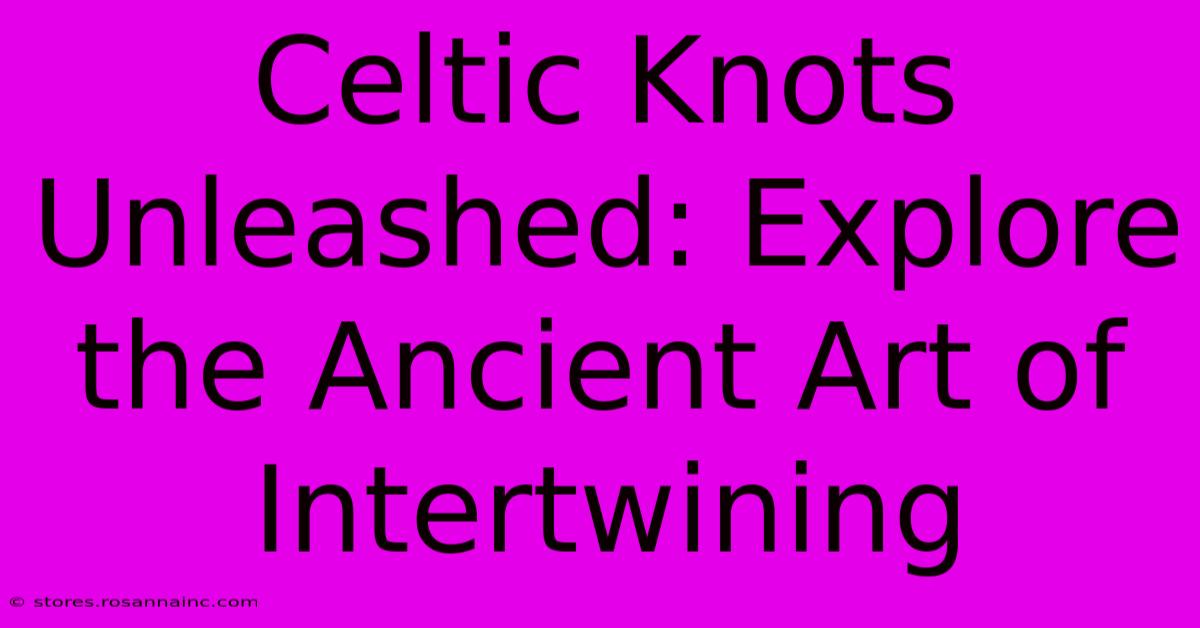Celtic Knots Unleashed: Explore The Ancient Art Of Intertwining

Table of Contents
Celtic Knots Unleashed: Explore the Ancient Art of Intertwining
Celtic knots. The very phrase conjures images of intricate designs, swirling patterns, and a deep connection to ancient history and spirituality. But what exactly are they, and why do they continue to fascinate us today? This exploration delves into the world of Celtic knots, uncovering their history, symbolism, and enduring appeal.
Decoding the Intricacies: A History of Celtic Knotwork
The origins of Celtic knotwork are shrouded in the mists of time, stretching back to the early centuries of the Common Era in the British Isles and parts of continental Europe. While precise origins remain debated, evidence suggests these mesmerizing designs flourished during the Insular art period (roughly 500-900 AD). Found adorning everything from illuminated manuscripts like the Book of Kells to intricate metalwork and stone carvings, these knots were far more than mere decoration.
More Than Just Pretty Pictures: The Symbolism of Celtic Knots
Celtic knotwork wasn't simply aesthetically pleasing; it held profound symbolic meaning for the ancient Celts. Many interpretations exist, often varying based on the specific knot design and cultural context. However, some recurring themes emerge:
-
Eternity and Infinity: The continuous, unbroken lines of the knots often symbolize the unending cycle of life, death, and rebirth. The lack of beginning or end reflects the cyclical nature of the cosmos and the eternal spirit.
-
Interconnectedness: The intricate weaving of the strands represents the interconnectedness of all things. Every element is linked, highlighting the harmony and balance within the universe.
-
Unity and Strength: The complex designs, despite their apparent chaos, demonstrate strength and unity. The interwoven strands represent the strength found in community and the power of collective effort.
-
Spiritual Growth and Transformation: Some scholars suggest the knots symbolized spiritual journeys and transformations. The intricate patterns might represent the complex paths individuals take on their spiritual quests.
Types of Celtic Knots: A Diverse World of Designs
The world of Celtic knots is remarkably diverse. While variations exist, some common types include:
-
Trinity Knot (Triquetra): This iconic knot, often featuring three interlocked loops, symbolizes the Holy Trinity in Christian interpretations, but for the Celts, it likely represented the triple goddesses or the interconnectedness of land, sea, and sky.
-
Celtic Cross: This fusion of a Christian cross and a Celtic knot combines religious symbolism with ancient tradition.
-
Endless Knot: This knot, with its continuous flow, powerfully symbolizes eternity and the unending cycle of life.
The Enduring Legacy: Celtic Knots in Modern Times
Celtic knotwork's allure continues to resonate today. Its intricate beauty transcends time and culture, finding its way into modern designs across various mediums:
-
Jewelry: Necklaces, bracelets, and rings featuring Celtic knot designs remain popular, allowing individuals to wear a piece of history.
-
Fashion: Celtic knot patterns appear on clothing, showcasing the timeless appeal of this ancient art.
-
Tattoo Art: Intricate Celtic knot tattoos represent personal journeys, beliefs, and a connection to heritage.
-
Interior Design: Celtic knot patterns add a touch of ancient elegance and sophistication to home decor.
Unleash Your Creativity: Exploring Celtic Knots Further
The beauty of Celtic knots lies not only in their rich history and symbolism but also in their adaptability. Numerous resources, books, and online tutorials are available for those interested in learning more about creating their own Celtic knot designs. Whether you're a seasoned artist or a curious beginner, the world of Celtic knotwork offers endless possibilities for exploration and creative expression. Embrace the challenge, unleash your creativity, and experience the magic of these ancient, intertwining designs.

Thank you for visiting our website wich cover about Celtic Knots Unleashed: Explore The Ancient Art Of Intertwining. We hope the information provided has been useful to you. Feel free to contact us if you have any questions or need further assistance. See you next time and dont miss to bookmark.
Featured Posts
-
Where Opulence Meets Tranquility Parkside On The Rivers Waterfront Masterpiece
Feb 05, 2025
-
Unlocking The Secrets Of Astrophotography Viltrox Fe 20mm F2 8 Lets You Capture The Night Sky Like Never Before
Feb 05, 2025
-
Level Up Your Imagination With Cherry Mocha D And D The Ultimate Blend For Adventure Seekers
Feb 05, 2025
-
The Devils Currency Unlocking The Dark Truths Of Medieval Woodcut Bills
Feb 05, 2025
-
Unlock The Secrets Of Effortless File Conversion Word To Google Doc In A Flash
Feb 05, 2025
